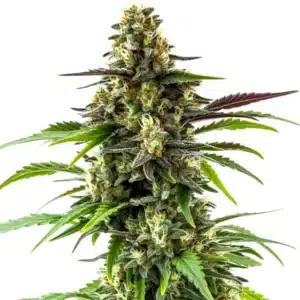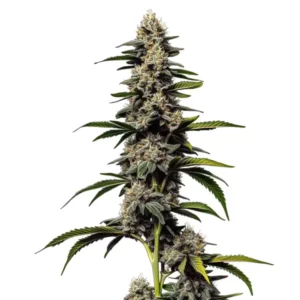Mids weed, short for “middle-grade” cannabis, sits between high-quality strains and lower-grade options like regs. Mids weed strain offers a solid middle ground for many cannabis users. These strains typically have moderate THC levels, ranging from 10% to 16%, which can still deliver a decent high without overwhelming the user.
What sets mids apart from lower-quality cannabis is its balanced profile, making it a popular choice among mid grade weed strains users. It’s more flavorful and visually appealing than regs, often showcasing bright green buds with orange hairs. Unlike higher-tier strains that are carefully trimmed and cured to perfection, mids might not have the same level of care during processing, but they still represent a solid middle ground for both casual and medicinal users.
Characteristics of Mids Weed
Mids weed generally has a brighter appearance compared to low-grade cannabis, though it won’t shine with the same trichome intensity as top-shelf options. This is typical for mid grade weed strains, where appearance and effects are balanced. The buds are typically green with hints of orange pistils and may display some crystal-like trichomes, but these are usually less pronounced than those found in premium strains. The texture of mids tends to be less dense, and while it may be slightly drier, it shouldn’t crumble to dust.
In terms of aroma and flavor, mids offer a middle-of-the-road experience. You can expect a pleasant, though not overly pungent smell, and a mild taste compared to the more robust profiles of higher-grade weed. This makes mids ideal for those who enjoy cannabis casually without the need for overwhelming potency or strong terpene profiles.
Promos & Deals
Pros of Mid-Grade Weed
One of the biggest advantages of mids weed is its affordability. It provides a solid cannabis experience without breaking the bank, making it accessible to more users. If you’re looking to stretch your budget, mids offer good value for the price. Many dispensaries carry mids as a more cost-effective alternative to top-shelf options, allowing you to get more weed for less money.
Another benefit is that mids weed strikes a balance in potency. For users who want to avoid the strong effects of high-THC strains, mids provide a moderate high that can be perfect for social situations, relaxation, or even mild medicinal use. The lower THC content also makes it a safer choice for beginners who are still gauging their tolerance.
Cons of Mid-Grade Weed
While mids have their advantages, there are also some downsides to consider. One of the most noticeable is the lack of flavor complexity. Compared to higher-grade strains, mids weed often has a more muted aroma and taste, which can be disappointing for connoisseurs who enjoy the rich terpene profiles of top-shelf varieties.
Additionally, the potency of mids may not be enough for experienced cannabis users seeking a more intense high. For those with a higher tolerance, mids might not provide the desired effects, and the user may need to consume more to achieve a similar high. Moreover, because mids are often less rigorously cured and stored, there is a higher risk of finding buds that are too dry or even slightly contaminated.

What Are Regs, Mids, Headies, and Beasters?
Cannabis quality is often categorized into four main levels: regs, mids, beasters, and headies. Each grade represents a different level of potency, flavor, and overall experience. Understanding the distinctions between these categories can help you make more informed decisions when purchasing cannabis. Regs, for example, are the lowest grade, while headies are the top-tier, premium-quality strains.
Mid strains fall between regs and beasters in terms of quality. Beasters, which are also known as “BC bud,” are generally higher quality than mids, offering more potency and a stronger flavor profile. Headies are the crème de la crème, boasting high THC levels, vibrant colors, and a rich terpene profile that delivers both in flavor and aroma.
Regs
Regs, short for “regulars,” are the lowest grade of cannabis you can find. They are typically brownish in color, often contain seeds and stems, and lack the visual appeal and potency of higher-grade strains. The THC content in regs is usually below 10%, making it less effective for recreational use and generally unappealing to seasoned users.
In terms of effects, regs provide a mild and sometimes unpleasant high. They’re often dry and harsh on the throat, with little flavor or aroma. Because of their low quality, regs are usually much cheaper than other types of cannabis, but many users prefer to avoid them unless cost is the only factor in their decision.
Mids
Mids are a significant step up from regs, both in appearance and potency. They tend to have a greener color, fewer stems, and sometimes even a few trichomes that indicate a higher THC content. While the buds are not as dense or frosty as top-tier strains, mids are still a decent option for those looking for a balance between quality and price.
Although the flavor and aroma are less pronounced, mids provide a smooth, enjoyable smoking experience. They contain enough THC to deliver a moderate high, making them suitable for casual use without overwhelming the user. For many, mids represent the best value, offering a good mix of affordability and effectiveness.
Beasters
Beasters, often associated with BC Bud (from British Columbia), represent a higher quality of cannabis than mids. These buds are usually denser, have more vibrant colors, and are covered in visible trichomes, making them more visually appealing. Beasters typically have a THC content ranging from 15% to 20%, providing a stronger high than mids.
Beasters are also known for their more intense flavor and aroma, which can be smoother and less harsh on the throat. While they don’t quite match the potency or terpene richness of headies, beasters are a solid choice for those who want a stronger high without paying top-shelf prices.
Headies
Headies, or top-shelf weed, are the highest-quality cannabis you can find. These buds are carefully cultivated, trimmed, and cured to preserve their trichomes, terpenes, and cannabinoids. They are often covered in a frosty layer of crystals, and their vibrant colors and pungent aroma make them stand out.
Headies are known for their high THC content, often exceeding 20%, and they deliver a potent high that can be overwhelming for novice users. The flavor profile is rich and complex, offering a smooth smoking experience with intense effects that can last for hours. Headies are typically more expensive, but for those seeking the best cannabis experience, they are well worth the investment.
Reasons for Choosing Mids Weed
Mids weed stands out as a balanced option for many cannabis users who are looking for a moderate experience. Its THC content, typically ranging from 10% to 16%, makes it appealing to those who want a relaxing high without the overpowering effects that come from stronger strains. Because of this, mids are perfect for social settings, casual use, or even for those seeking medicinal benefits without the intensity of top-shelf cannabis. They offer enough potency to provide a satisfying high, but without pushing the boundaries that might lead to discomfort or anxiety in some users.
Additionally, the price point of mids weed is a major factor in its popularity. Being significantly more affordable than premium strains, mids offer a solid cannabis experience without the high cost. This affordability makes it a favorite among users who want quality weed but are mindful of their budget. It also allows for more flexibility, whether you are looking to buy in larger quantities or create cannabis-infused products such as edibles. Mids provide an excellent balance between cost and experience, making them accessible to a wider audience.

Affordability
One of the key reasons people choose mids is their cost-effectiveness. Compared to top-shelf cannabis, mids are often available at a fraction of the price, sometimes up to 50% less. This makes it easier for users to purchase larger amounts without significantly increasing their spending. For budget-conscious consumers, mids provide a viable option that still delivers decent quality and effects. Their lower price allows users to get more value for their money, especially in regions where cannabis can be expensive.
For regular consumers, the financial savings offered by mids are substantial. Instead of limiting consumption due to high costs, users can afford to enjoy cannabis more frequently. This is particularly important for those who need cannabis for medicinal purposes, as consistent use is often necessary to manage symptoms. Mids provide an accessible option that allows these users to maintain their regimen without financial strain.
Bulk purchasing also becomes more feasible when choosing mids. Many dispensaries offer mids in larger quantities at discounted rates, making it even more affordable to stock up. Whether you’re preparing for social gatherings, baking edibles, or simply looking to extend your supply, mids offer the flexibility to buy in larger amounts without overspending.
Tolerance and Experience
Mid strains are an ideal choice for those with a lower THC tolerance or those new to cannabis. The moderate THC content means that the effects are less intense, reducing the likelihood of anxiety or paranoia that can come from stronger strains. Mids provide a manageable experience, making them a safer and more enjoyable option for people who are still building their tolerance or prefer a milder high. This makes them suitable for both casual users and those seeking a more controlled cannabis experience without feeling overwhelmed.
The balanced high of mids is also perfect for users who enjoy cannabis in social settings. The effects are mild enough to allow for conversation, focus, and engagement without the disorienting effects of stronger strains. Mids are a great option for people who want to share cannabis with friends but prefer to reserve top-shelf strains for more personal use. Additionally, mids allow for a gradual increase in tolerance, giving new users the opportunity to explore their limits in a safe and comfortable way.
Medicinal
Mids weed can be an excellent option for medicinal users who need relief from symptoms but don’t want the overwhelming high that often accompanies high-THC strains. For conditions such as anxiety, mild pain, or sleep issues, the moderate potency of mids offers enough therapeutic benefits without the risk of adverse effects like paranoia or excessive sedation.
In addition, mids weed can often contain a balanced ratio of cannabinoids such as THC and CBD, making it effective for users seeking medical benefits without solely relying on psychoactive effects. This balance is particularly beneficial for daytime use, where users need relief but still want to maintain functionality throughout the day.
A Sense of Nostalgia
For long-time cannabis users, mids can evoke a sense of nostalgia, reminding them of a time when weed was simpler and less refined. Before legalization brought about the rise of highly potent, lab-cultivated strains, many people were accustomed to smoking mid-grade weed. This connection to the past adds a sentimental value to mids for some users.
In regions where cannabis quality has improved dramatically over the past decade, smoking mids can offer a glimpse back to the days when the market was less saturated with high-THC options. For many, mids represent a familiar and comfortable middle ground that delivers a solid high without being too extravagant.
Baking Edibles
Mids weed is also a great option for making cannabis edibles. Since the process of decarboxylation (the heating process that activates THC) and infusion into oils or butters diminishes the flavor profile, using high-end strains may not be worth the extra cost. Mids provide the necessary cannabinoids without wasting premium buds.
Another advantage of using mids for edibles is that they allow you to make large batches without spending as much money. Whether you’re preparing brownies, gummies, or infused oils, mids offer an effective, budget-friendly option that still delivers potent, long-lasting effects.
Downsides of Mids Cannabis
Despite the benefits, mids cannabis does have its drawbacks. One major downside is the limited terpene profile. spray Terpenes are the compounds that give cannabis its distinctive flavors and aromas, and in top-shelf weed, these are often highly pronounced. In mid strains, however, the terpene content is typically much lower, resulting in a less flavorful and aromatic experience.
Another disadvantage is the reduced effects compared to higher-end strains. While mids can provide a pleasant high for casual users, seasoned cannabis consumers may find that the moderate THC levels don’t meet their expectations. For those with a higher tolerance, mids might require larger doses to achieve the desired effects, which can diminish the overall value.

Limited Terpene Profile
As mentioned, mids weed tends to have a less complex terpene profile than top-shelf strains. This results in a more muted flavor and aroma, which can be disappointing for users who enjoy the sensory experience of smoking cannabis. High-quality strains are often known for their pungent, unique smells, which are lacking in mids.
Additionally, the limited terpene profile can affect the overall effects of the strain. spray Terpenes play a role in modulating the high, and without a robust presence of these compounds, the effects of mids may feel less dynamic or balanced. For connoisseurs who appreciate the full cannabis experience, this can be a significant downside.
Reduced Effects
For experienced cannabis users, the reduced potency of mids can be a drawback. With THC levels typically ranging from 10% to 16%, mids may not provide the strong high that some users are accustomed to. Those with a higher tolerance may need to consume more mids to achieve their desired effects, which can lead to diminishing returns.
While mids are perfect for casual use or those who prefer a milder experience, they often fall short for consumers who enjoy the intense effects of top-shelf weed. This reduced potency can make mids less appealing to long-time users who are used to stronger strains with THC concentrations upwards of 20%.
Potential Contaminants
One of the risks associated with mids weed is the potential for contaminants. Because mids are often less rigorously curated than top-tier strains, they may be exposed to mold, mildew, or other impurities during the growing, drying, or storage process. This can happen especially when buds are not stored properly in dry, ventilated areas.
In some cases, you might also encounter seeds or stems in mids weed, which, while not harmful, can lower the quality of your experience. Always inspect your mids before using them to ensure there are no visible signs of contamination. If you notice any mold or discoloration, it’s best to avoid consuming that batch.
How to Identify Mids Weed
Identifying mids weed can be tricky, especially as the overall quality of cannabis has improved in recent years. However, there are a few key characteristics to look out for when trying to distinguish mids from lower or higher-grade weed. Mids are typically greener than regs, with visible orange hairs and some trichomes, but they won’t have the frosty, crystal-coated appearance of top-shelf strains.
The texture of mids weed is also a clue. While it may not be as dense as premium buds, it shouldn’t feel too dry or crumble too easily. Mids should have a balanced feel when squeezed gently, indicating a decent moisture content. In terms of aroma, mids usually have a pleasant smell, though it won’t be as intense or complex as higher-grade weed.
FAQs
What is the main difference between mids and top-shelf weed?
The key distinction between mids and top-shelf weed lies in their quality and overall experience. Top-shelf strains usually have higher THC content, often exceeding 20%, while mids contain around 10-16%. Additionally, top-shelf weed boasts a richer terpene profile, giving it a more intense aroma and flavor. Top-shelf buds are also denser, more vibrant, and often covered in trichomes, resulting in a frostier appearance. Mids, while still enjoyable, lack this intensity in both flavor and potency, making them a good option for casual use.
Is mids weed a good choice for beginners?
Yes, mids are an excellent choice for beginners due to their moderate potency. With THC levels ranging from 10% to 16%, they provide a balanced high that is unlikely to overwhelm new users. Mids allow beginners to experience the effects of cannabis without the intensity that comes from high-end strains, which can sometimes induce anxiety or paranoia. Additionally, mids offer a more affordable entry point into cannabis use, allowing first-timers to explore their tolerance levels without spending too much.
Can I bake edibles with mids weed?
Definitely! Mids are a cost-effective option for baking edibles, as their moderate potency is perfect for recipes where the cannabis flavor is not the primary focus. The cannabinoids in mids will still provide the desired effects in edibles, whether you’re looking for relaxation or mild pain relief. Moreover, since the process of cooking can reduce the terpene profile, using top-shelf weed might not be worth the extra cost. Mids provide a great balance between potency and price for any edible-making endeavor.
How do I tell if my weed is mids or regs?
You can distinguish mids from regs by their appearance, texture, and overall quality. Mids weed tends to be green with some orange pistils and trichomes, whereas regs are typically brownish and dry, often containing seeds and stems. The buds of mids are firmer and better cured than regs, which are usually low-quality and harsh to smoke. Mids provide a smoother experience with fewer stems and seeds, making them significantly better than regs in both potency and overall enjoyment.
Can mids weed go bad?
Yes, mids weed can go bad if not stored correctly. Like all cannabis, mids need to be kept in a cool, dry place, ideally in an airtight container to prevent mold and maintain freshness. Improper storage can lead to the growth of mold, especially in humid environments, or cause the buds to dry out, resulting in a harsh smoke and a loss of potency. Always check for any signs of mold or an overly dry texture before use, as these are indicators that the weed may no longer be safe to consume.
















